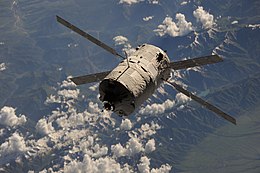
The European Space Agency (ESA) is a 22-member intergovernmental body devoted to space exploration. With its headquarters in Paris and a staff of around 2,200 people globally as of 2018, ESA was founded in 1975. By 2023, it will have an annual budget of about €7.08 billion.

The Progress is a Russian expendable cargo spacecraft. Its purpose is to deliver the supplies needed to sustain a human presence in orbit. While it does not carry a crew, it can be boarded by astronauts when docked to a space station, hence it is classified as crewed by its manufacturer. Progress is derived from the crewed Soyuz spacecraft and launches on the same launch vehicle, a Soyuz rocket.

The Guiana Space Centre, also called Europe's Spaceport, is a European spaceport to the northwest of Kourou in French Guiana, a region of France in South America. Kourou is located approximately 310 mi (500 km) north of the equator at a latitude of 5°. In operation since 1968, it is a suitable location for a spaceport because of its equatorial location and open sea to the east.

The Automated Transfer Vehicle, originally Ariane Transfer Vehicle or ATV, was an expendable cargo spacecraft developed by the European Space Agency (ESA), used for space cargo transport in 2008–2015. The ATV design was launched to orbit five times, exclusively by the Ariane 5 heavy-lift launch vehicle. It effectively was a larger European counterpart to the Russian Progress cargo spacecraft for carrying upmass to a single destination—the International Space Station (ISS)—but with three times the capacity.

Uncrewed spaceflights to the International Space Station (ISS) are made primarily to deliver cargo, however several Russian modules have also docked to the outpost following uncrewed launches. Resupply missions typically use the Russian Progress spacecraft, European Automated Transfer Vehicles, Japanese Kounotori vehicles, and the American Dragon and Cygnus spacecraft. The primary docking system for Progress spacecraft is the automated Kurs system, with the manual TORU system as a backup. ATVs also use Kurs, however they are not equipped with TORU. The other spacecraft — the Japanese HTV, the SpaceX Dragon and the Northrop Grumman Cygnus — rendezvous with the station before being grappled using Canadarm2 and berthed at the nadir port of the Harmony or Unity module for one to two months. Progress, Cygnus and ATV can remain docked for up to six months. Under CRS phase 2, Cargo Dragon docks autonomously at IDA-2 or 3 as the case may be. As of December 2022, Progress spacecraft have flown most of the uncrewed missions to the ISS.

The ISS Propulsion module, functions performed by the Zvezda Service Module and Progress spacecraft. Critical ISS functionality such as guidance, navigation, control and propulsion are provided only by Russian and the European (ATV) spacecraft. A Propulsion Module would have been needed for ISS altitude maintenance and reboost, debris avoidance maneuvers, attitude control and propellant supply in the event the Zvezda Service Module was not available to the International Space Station. If the Zvezda had not been available, the Interim Control Module would have been used at first. It only had a lifetime of three years; then the Propulsion Module would have been necessary.
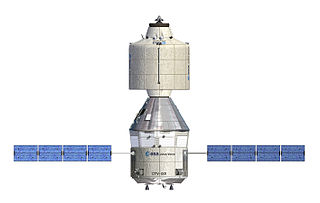
Crew Space Transportation System (CSTS), or Advanced Crew Transportation System (ACTS), was a proposed design for a crewed spacecraft for low Earth orbit operations such as servicing the International Space Station, but also capable of exploration of the Moon and beyond. It was originally a joint project between the European Space Agency (ESA) and the Roscosmos, but later became solely an ESA project. This study was conceived as a basic strategic plan to keep a viable European human spaceflight program alive.

ELA-3, is a launch pad and associated facilities at the Centre Spatial Guyanais in French Guiana. ELA-3 was operated by Arianespace as part of the expendable launch system for Ariane 5 launch vehicles. As of July 2023, 117 launches have been carried out from it, the first of which occurred on 4 June 1996. The final launch occurred on 5 July 2023.

The Jules Verne ATV, or Automated Transfer Vehicle 001 (ATV-001), was a robotic cargo spacecraft launched by the European Space Agency (ESA). The ATV was named after the 19th-century French science-fiction author Jules Verne. It was launched on 9 March 2008 on a mission to supply the International Space Station (ISS) with propellant, water, air, and dry cargo. Jules Verne was the first of five ATVs to be launched.

The Johannes Kepler ATV, or Automated Transfer Vehicle 002 (ATV-002), was an uncrewed cargo spacecraft built to resupply the International Space Station (ISS). It was launched on February 16, 2011 by the European Space Agency (ESA). Johannes Kepler carried propellant, air and dry cargo weighing over 7,000 kilograms (15,000 lb), and had a total mass of over 20,000 kilograms (44,000 lb), making it, at the time, the heaviest payload launched by the ESA. The spacecraft was named after the 17th-century German astronomer Johannes Kepler.

Expedition 28 was the 28th long-duration expedition to the International Space Station, and began on 23 May 2011 with the departure of the members of Expedition 27. The first three members of Expedition 28 arrived on the ISS aboard the Soyuz TMA-21 spacecraft on 4 April 2011, and were joined on 9 June 2011 by the three other crew members, who arrived aboard Soyuz TMA-02M. The expedition saw a number of significant events, including the final Space Shuttle mission, STS-135, which took place in July 2011. Expedition 28 was superseded by Expedition 29 on 16 September 2011.
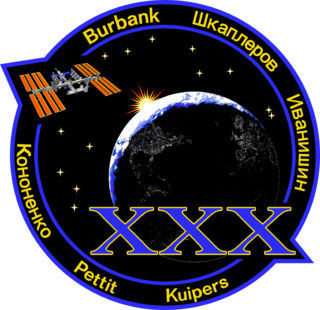
Expedition 30 was the 30th long-duration mission to the International Space Station (ISS). The expedition's first three crew members – Dan Burbank, Anton Shkaplerov and Anatoli Ivanishin – arrived on the ISS aboard Soyuz TMA-22 on 16 November 2011, during the last phase of Expedition 29. Expedition 30 formally began on 21 November 2011, with the departure from the ISS of the Soyuz TMA-02M spacecraft. The expedition ended on 27 April 2012, as Burbank, Shkaplerov and Ivanishin departed from the ISS aboard Soyuz TMA-22, marking the beginning of Expedition 31.
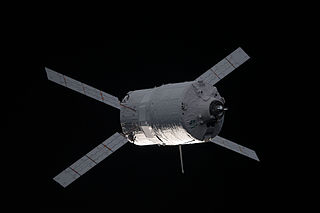
The Edoardo Amaldi ATV, or Automated Transfer Vehicle 003 (ATV-003), was a European uncrewed cargo spacecraft, named after the 20th-century Italian physicist Edoardo Amaldi. The spacecraft was launched by the European Space Agency (ESA) on 23 March 2012, on a mission to supply the International Space Station (ISS) with propellant, water, oxygen, and dry cargo.

A Reentry Breakup Recorder (REBR) is a device that is designed to be placed aboard a spacecraft to record pertinent data when the spacecraft (intentionally) breaks up as it re-enters Earth's atmosphere.

Progress M-11M, identified by NASA as Progress 43P, is a Progress spacecraft which was launched on 21 June 2011 to resupply the International Space Station. It was the eleventh Progress-M 11F615A60 spacecraft to be launched. The spacecraft is manufactured by RKK Energia, and will be operated by the Russian Federal Space Agency. Progress M-11M transferred more than 2500 kg of cargo to the Space Station, including food, water, scientific hardware, propellant, and cargo for the Russian Federal Space Agency (Roscosmos), NASA and the Japanese Space Agency, (JAXA).

The Georges Lemaître ATV, or Automated Transfer Vehicle 5 (ATV-5), was a European uncrewed cargo spacecraft, named after the Belgian astronomer Georges Lemaître. The spacecraft was launched during the night of 29 July 2014, on a mission to supply the International Space Station (ISS) with propellant, water, air, and dry cargo. It was the fifth and final ATV to be built and launched. Georges Lemaître was constructed in Turin, Italy, and Bremen, Germany. Cargo loading was completed in Guiana Space Center on 23 July 2014.

The European contribution to the International Space Station comes from 10 members of the European Space Agency (ESA) and amounts to an 8% share in the programme. It consists of a number of modules in the US Orbital Segment, ATV supply ships, launchers, software and €8 billion.

Progress M-19M, identified by NASA as Progress 51P, is a Progress spacecraft used by Roskosmos to resupply the International Space Station during 2013. Progress M-19M was launched on a standard 2-day rendezvous profile towards the ISS. The 19th Progress-M 11F615A60 spacecraft to be launched, it had the serial number 419 and was built by RKK Energia.

Ariane Flight VA245 is the Ariane 5 space launch of BepiColombo that took place on 20 October 2018 at 01:45:28 UTC from the Guiana Space Centre. It was the 101st launch of Ariane 5, and the 301st Arianespace mission.
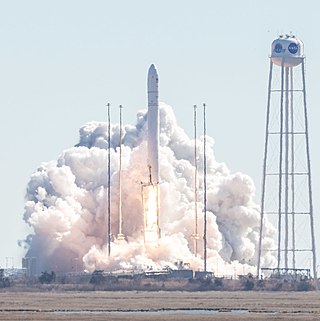
Cygnus NG-17, previously known as Cygnus OA-17, was the seventeenth flight of the Northrop Grumman robotic resupply spacecraft Cygnus and its sixteenth flight to the International Space Station (ISS) under the Commercial Resupply Services (CRS) contract with NASA. The mission launched on 19 February 2022 at 17:40:03 UTC. It was the sixth launch of Cygnus under the CRS-2 contract.
